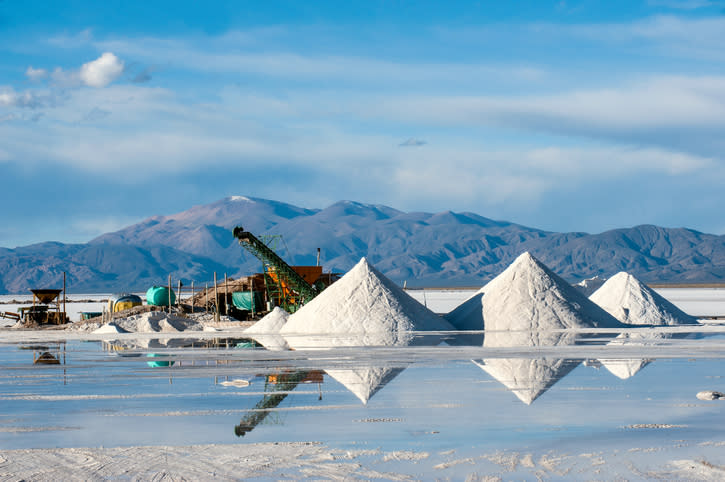Better Buy: Albemarle vs. Sociedad Quimica y Minera
The 19th century had steel. The 20th century had petroleum. It's still early, but it appears the 21st century might just be shaped and molded by lithium. The white metal is increasingly important for energy storage devices and electric vehicles, and it's even an important component in the lightweight alloys used to manufacture fuel tanks for SpaceX rockets.
If that doesn't draw investors to the lithium value chain, then it might only take one look at the growth trajectory. Global demand for lithium is expected to climb from only 175,000 metric tons of lithium carbonate equivalent (LCE) in 2015 to as much as 1.2 million metric tons of LCE by 2025.
When it comes to investment opportunities, investors are sure to come across two of the largest lithium producers on the planet: Albemarle (NYSE: ALB) and Sociedad Quimica y Minera (SQM) (NYSE: SQM). But one business is better positioned to meet the growing needs of customers than the other.

Image source: Getty Images.
The matchup
Albemarle turned in a solid year of operations in 2018. Total revenue and gross profit each grew 10% year over year, while operating profit climbed 23%, excluding gains from asset sales. As has been the case for the past several years, the business is being driven by its lithium segment.
While the lithium segment made up 36% of total revenue, it was responsible for 47.5% of total adjusted EBITDA. Albemarle's other segments, bromine specialties and catalysts, weren't exactly slouches; it's simply that strong selling prices for lithium products are providing incredible margins. Thanks to the rapid build-out of battery manufacturing facilities across the globe by automakers and their joint venture partners, the strong fundamentals of the lithium market are expected to remain in place for the foreseeable future.
That's also driving capital investment decisions among lithium producers. Albemarle has seven separate expansion projects on tap that are expected to come online between this year and 2025 -- or sooner, depending on market demand. The first wave will boost annual production capacity from 65,000 metric tons of LCE at the end of 2018 to as much as 175,000 metric tons by the end of 2021, while the second wave could increase that up to 350,000 metric tons by 2025. Considering that a significant amount of the expansion capacity is already entered into long-term offtake agreements, investors should feel pretty good about the company's long-term future.

A lithium brine mining operation. Image source: Getty Images.
SQM didn't enjoy the same all-around operational strength in 2018 as Albemarle, but it achieved growth where it mattered most. Revenue from its lithium segment grew 14% year over year, outpacing total revenue growth of 5% in that span. Recovering selling prices for agricultural fertilizers led to a 12% year-over-year increase in revenue for the segment, the company's largest, while expansion efforts in the iodine business paid off with 29% revenue growth compared with 2017.
That said, the lithium segment remains the driving force for the company, accounting for 53% of total gross profit for it last year. SQM estimates the global lithium market grew 27% year over year in 2018 and anticipates at least 20% growth in 2019.
Soaring demand for lithium underpins the expansion strategy of SQM, too. The company sold 45,100 metric tons of LCE in 2018 -- a nearly 5% decline from 2017, believe it or not -- but has plans to grow annual production capacity to 180,000 metric tons by the mid-2020s.

Image source: Getty Images.
By the numbers
Both Albemarle and SQM are enjoying impressive growth from their lithium segments. Both businesses have plans for impressive expansion. But, somewhat curiously, despite having a smaller overall operational footprint, SQM is the larger company ranked by market cap right now. Perhaps Chile's lithium leader is being rewarded for its higher dividend yield or its more diverse operations. Or, most likely, because it has consistently delivered higher rates of return on invested capital than its peer since at least 2005. But that gap has begun to close in the last 12 months (albeit, it's just 12 months), and there's no denying SQM is more expensive than Albemarle in several important valuation metrics.
Metric | Albemarle | SQM |
|---|---|---|
Market cap | $8.7 billion | $9.9 billion |
5-year stock return (including dividends) | 36% | 49% |
Dividend yield | 1.8% | 3.2% |
Forward PE | 12.1 | 16.8 |
1.0 | 2.7 | |
Price to sales | 2.6 | 4.3 |
Data source: Yahoo! Finance.
The discrepancy in current valuations makes even less sense when investors consider the expected divergence in lithium production just over the horizon. While both companies exited 2018 with roughly the same annual production capacity, Albemarle could have close to double SQM's lithium output by 2025. That might settle the score for investors with a long-term mindset.
The better buy is...
Based on valuation metrics and a more ambitious expansion in lithium, Albemarle is the better buy in this matchup. Although SQM pays a higher dividend yield, and could be sitting on a gold mine should fertilizer prices reach historic levels in the next decade, Albemarle's plan to absolutely dominate the global lithium market by 2025 is a significant advantage that outweighs just about everything else in this comparison. It just has to execute its expansion strategy and bring new production capacity online on time and on budget.
More From The Motley Fool
Maxx Chatsko has no position in any of the stocks mentioned. The Motley Fool has no position in any of the stocks mentioned. The Motley Fool has a disclosure policy.

 Yahoo Finance
Yahoo Finance 